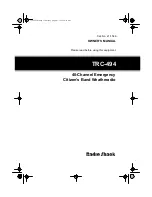
Exalt Installation and Management Guide
ExtendAir (TDD) Series
64
203591-004
2010-09-20
The Temperature alarm monitors the internal temperature of the unit based on specific points inside
the radio chassis. It is normal for the internal temperature to be above the ambient temperature, so the
temperature reading may be higher than the highest specified ambient temperature. When the internal
electronics reach a point that is higher than the normal temperature rise at the highest ambient
temperature, the temperature alarm turns yellow. Power down the radio as soon as possible, and
investigate the cause of the temperature rise before the radio is put back into service. In almost all
cases, a temperature alarm is due to an external cause.
Table 6 Alarm status indicators
Label
Status
Link
Indicates RF link status:
•
Green Solid = Error-free connection (BER<10e-6)
•
Yellow Solid = Errored connection (10e-3>BER >10e-6)
•
Red Solid = No link (BER>10e-3)
DFS
Indicates the status of the Dynamic Frequency Selection (DFS).
•
Green = No DFS activity, normal transmission
•
Red = Either CAC or NOP is in progress.
Collocation
Indicates the enabled/disabled status with Internal or GPS sync and current alarm status.
•
Green Solid = Sync enabled and sync input present
•
Yellow Solid = Sync enabled and missing proper sync input in flywheel operation period
•
Red Solid = Sync enabled and missing proper sync input signal and flywheel period
expired
Ethernet
•
Green Solid = Alarm Enabled and Ethernet Link present
•
Red = Alarm Enabled and Ethernet Link not present
•
Grey = Alarm Disabled
T1/E1 Input
•
Green = Enabled and connection present (clocking confirmed)
•
Red = Enabled and no connection present
•
Grey = Disabled and no connection present
Temperature
•
Green Solid = Normal temperature range
•
Yellow Solid = Exceeding normal temperature range
















































